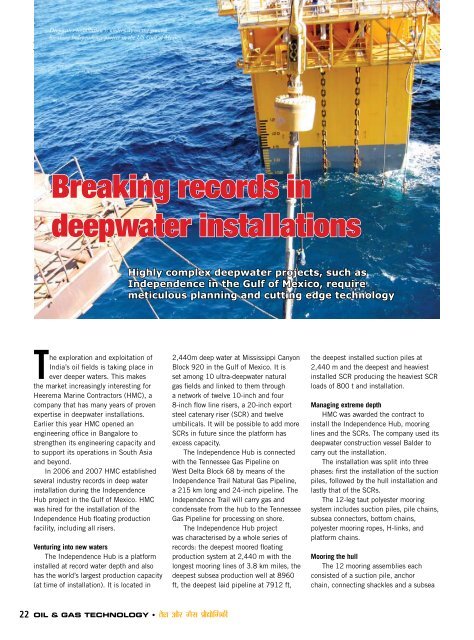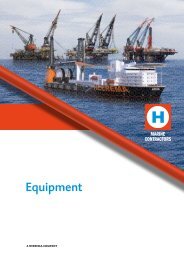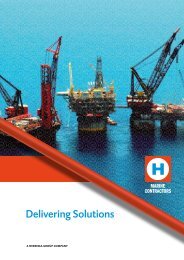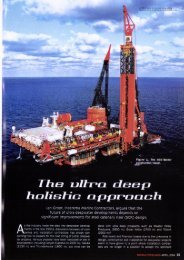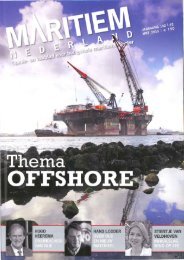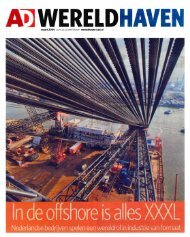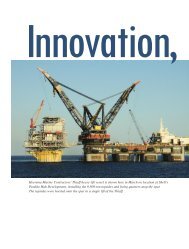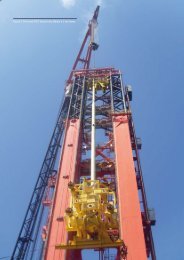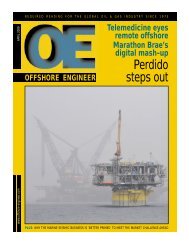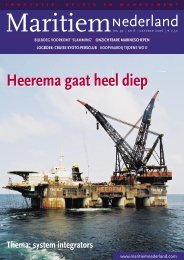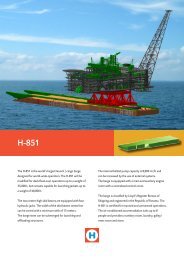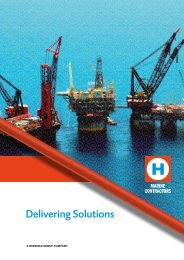Breaking records in deepwater installations - Heerema Marine ...
Breaking records in deepwater installations - Heerema Marine ...
Breaking records in deepwater installations - Heerema Marine ...
You also want an ePaper? Increase the reach of your titles
YUMPU automatically turns print PDFs into web optimized ePapers that Google loves.
Deepwater <strong>in</strong>stallation is underway on the groundbreak<strong>in</strong>g<br />
Independence project <strong>in</strong> the US Gulf of Mexico<br />
English Eyebrow<br />
English Eyebrow<br />
<strong>Break<strong>in</strong>g</strong> <strong>records</strong> <strong>in</strong><br />
<strong>deepwater</strong> <strong>in</strong>stallations<br />
The exploration and exploitation of<br />
India’s oil fields is tak<strong>in</strong>g place <strong>in</strong><br />
ever deeper waters. This makes<br />
the market <strong>in</strong>creas<strong>in</strong>gly <strong>in</strong>terest<strong>in</strong>g for<br />
<strong>Heerema</strong> Mar<strong>in</strong>e Contractors (HMC), a<br />
company that has many years of proven<br />
expertise <strong>in</strong> <strong>deepwater</strong> <strong>in</strong>stallations.<br />
Earlier this year HMC opened an<br />
eng<strong>in</strong>eer<strong>in</strong>g office <strong>in</strong> Bangalore to<br />
strengthen its eng<strong>in</strong>eer<strong>in</strong>g capacity and<br />
to support its operations <strong>in</strong> South Asia<br />
and beyond.<br />
In 2006 and 2007 HMC established<br />
several <strong>in</strong>dustry <strong>records</strong> <strong>in</strong> deep water<br />
<strong>in</strong>stallation dur<strong>in</strong>g the Independence<br />
Hub project <strong>in</strong> the Gulf of Mexico. HMC<br />
was hired for the <strong>in</strong>stallation of the<br />
Independence Hub float<strong>in</strong>g production<br />
facility, <strong>in</strong>clud<strong>in</strong>g all risers.<br />
Ventur<strong>in</strong>g <strong>in</strong>to new waters<br />
The Independence Hub is a platform<br />
<strong>in</strong>stalled at record water depth and also<br />
has the world’s largest production capacity<br />
(at time of <strong>in</strong>stallation). It is located <strong>in</strong><br />
22 OIL & GAS TECHNOLOGY • rsy vkSj xSl ÁksS|ksfxdh<br />
Highly complex <strong>deepwater</strong> projects, such as<br />
Independence <strong>in</strong> the Gulf of Mexico, require<br />
meticulous plann<strong>in</strong>g and cutt<strong>in</strong>g edge technology<br />
2,440m deep water at Mississippi Canyon<br />
Block 920 <strong>in</strong> the Gulf of Mexico. It is<br />
set among 10 ultra-<strong>deepwater</strong> natural<br />
gas fields and l<strong>in</strong>ked to them through<br />
a network of twelve 10-<strong>in</strong>ch and four<br />
8-<strong>in</strong>ch flow l<strong>in</strong>e risers, a 20-<strong>in</strong>ch export<br />
steel catenary riser (SCR) and twelve<br />
umbilicals. It will be possible to add more<br />
SCRs <strong>in</strong> future s<strong>in</strong>ce the platform has<br />
excess capacity.<br />
The Independence Hub is connected<br />
with the Tennessee Gas Pipel<strong>in</strong>e on<br />
West Delta Block 68 by means of the<br />
Independence Trail Natural Gas Pipel<strong>in</strong>e,<br />
a 215 km long and 24-<strong>in</strong>ch pipel<strong>in</strong>e. The<br />
Independence Trail will carry gas and<br />
condensate from the hub to the Tennessee<br />
Gas Pipel<strong>in</strong>e for process<strong>in</strong>g on shore.<br />
The Independence Hub project<br />
was characterised by a whole series of<br />
<strong>records</strong>: the deepest moored float<strong>in</strong>g<br />
production system at 2,440 m with the<br />
longest moor<strong>in</strong>g l<strong>in</strong>es of 3.8 km miles, the<br />
deepest subsea production well at 8960<br />
ft, the deepest laid pipel<strong>in</strong>e at 7912 ft,<br />
the deepest <strong>in</strong>stalled suction piles at<br />
2,440 m and the deepest and heaviest<br />
<strong>in</strong>stalled SCR produc<strong>in</strong>g the heaviest SCR<br />
loads of 800 t and <strong>in</strong>stallation.<br />
Manag<strong>in</strong>g extreme depth<br />
HMC was awarded the contract to<br />
<strong>in</strong>stall the Independence Hub, moor<strong>in</strong>g<br />
l<strong>in</strong>es and the SCRs. The company used its<br />
<strong>deepwater</strong> construction vessel Balder to<br />
carry out the <strong>in</strong>stallation.<br />
The <strong>in</strong>stallation was split <strong>in</strong>to three<br />
phases: first the <strong>in</strong>stallation of the suction<br />
piles, followed by the hull <strong>in</strong>stallation and<br />
lastly that of the SCRs.<br />
The 12-leg taut polyester moor<strong>in</strong>g<br />
system <strong>in</strong>cludes suction piles, pile cha<strong>in</strong>s,<br />
subsea connectors, bottom cha<strong>in</strong>s,<br />
polyester moor<strong>in</strong>g ropes, H-l<strong>in</strong>ks, and<br />
platform cha<strong>in</strong>s.<br />
Moor<strong>in</strong>g the hull<br />
The 12 moor<strong>in</strong>g assemblies each<br />
consisted of a suction pile, anchor<br />
cha<strong>in</strong>, connect<strong>in</strong>g shackles and a subsea
male connector. The components were<br />
assembled on board the Balder before<br />
be<strong>in</strong>g lifted and <strong>in</strong>stalled. The 27m long<br />
suction piles, weigh<strong>in</strong>g 180 t each, were<br />
<strong>in</strong>stalled at 2,442 m water depth, us<strong>in</strong>g<br />
Remotely Operated Vessels (ROVs) and<br />
transponders to verify orientation and<br />
position. All twelve piles were <strong>in</strong>stalled<br />
with<strong>in</strong> the required tolerances for<br />
position<strong>in</strong>g, orientation and <strong>in</strong>cl<strong>in</strong>ation.<br />
The first component of each moor<strong>in</strong>g<br />
l<strong>in</strong>e to be <strong>in</strong>stalled was the bottom cha<strong>in</strong><br />
with the subsea female connector. The<br />
Balder’s two cranes, capable of a tandem<br />
lift of 6,300 t, laid out the entire 244-mlong<br />
bottom cha<strong>in</strong> on deck to remove all<br />
twists and make the connection with the<br />
female connector.<br />
The cha<strong>in</strong> and connector were then<br />
lowered <strong>in</strong>to the water and the upper end<br />
was secured <strong>in</strong> a hang-off platform for<br />
the attachment to the polyester moor<strong>in</strong>g.<br />
The Balder’s Moor<strong>in</strong>g L<strong>in</strong>e<br />
Deployment W<strong>in</strong>ch (MLDW) was used<br />
to <strong>in</strong>stall the polyester moor<strong>in</strong>g l<strong>in</strong>e<br />
segments. They were connected to the<br />
bottom cha<strong>in</strong>, after which it was released<br />
from the hang-off platform. The female<br />
connector of the bottom cha<strong>in</strong> was<br />
IkkbIkYkkbUk IkzkS|ksfXkdh<br />
Pipel<strong>in</strong>e Technology<br />
The 12 moor<strong>in</strong>g assemblies each<br />
consisted of a suction pile, anchor<br />
cha<strong>in</strong>, connect<strong>in</strong>g shackles and a<br />
subsea male connector<br />
connected to the male connector on the<br />
moor<strong>in</strong>g pile.<br />
After the third segment was secured <strong>in</strong><br />
the hang-off table, the platform cha<strong>in</strong> was<br />
connected to the messenger cha<strong>in</strong> already<br />
<strong>in</strong>stalled at the hull. The platform cha<strong>in</strong><br />
was then lowered and the messenger<br />
cha<strong>in</strong> hauled <strong>in</strong> to transfer the moor<strong>in</strong>g<br />
l<strong>in</strong>e load to the semisubmersible. This
English Eyebrow<br />
Logistics issues are a major concern for service providers on projects of such a grand scale<br />
The Independence Hub project was characterised by a whole<br />
series of <strong>records</strong>: the deepest moored float<strong>in</strong>g production system<br />
at 2,440m with the longest moor<strong>in</strong>g l<strong>in</strong>es of 3.8km miles<br />
sequence was performed with each<br />
moor<strong>in</strong>g l<strong>in</strong>e, <strong>in</strong> total 12 times.<br />
The Balder also <strong>in</strong>stalled two flow l<strong>in</strong>es<br />
which were shorter than the water depth.<br />
One of the flow l<strong>in</strong>es was 997m long and<br />
was <strong>in</strong>stalled <strong>in</strong> a water depth of 2,464m,<br />
and the other was 1,964m long and was<br />
<strong>in</strong>stalled <strong>in</strong> water of 2,662m deep.<br />
Heaviest SCR load<br />
The last part HMC was contracted<br />
to carry out was the <strong>in</strong>stallation of the<br />
SCRs. This comprised five 8-<strong>in</strong>ch and<br />
two 10-<strong>in</strong>ch SCRs and the 20-<strong>in</strong>ch<br />
export SCR.<br />
Each SCR consists of a steel pipe with<br />
an <strong>in</strong>tegrated flex jo<strong>in</strong>t and the SCR head<br />
on the pipe end. To avoid vortex <strong>in</strong>duced<br />
vibrations the SCRs came pre-<strong>in</strong>stalled<br />
with strakes and fair<strong>in</strong>gs. They were laid<br />
out on the seabed prior to <strong>in</strong>stallation.<br />
Installation of the SCRs <strong>in</strong>volved<br />
some major acrobatics above and below<br />
24 OIL & GAS TECHNOLOGY • rsy vkSj xSl ÁksS|ksfxdh<br />
the water surface. The Balder used<br />
its Abandonment and Recovery (A&R)<br />
W<strong>in</strong>ch to recover each SCR from the<br />
seabed at almost 2,500 m water depth<br />
and then moved over 2km away from the<br />
IHUB to raise the SCR’s head some 25<br />
m above the seafloor. The Balder then<br />
moved close enough to the hub to cross<br />
haul the SCR under the hull to move it<br />
to the correct side of the platform and<br />
transfer the load from the A & R w<strong>in</strong>ch<br />
to the cross-haul wire. In the case of<br />
the export SCR the load amounted to an<br />
unprecedented 800 t.<br />
The Balder then reconnected the A&R<br />
w<strong>in</strong>ch to the SCR head for retrieval and<br />
transfer of the SCR to the IHUB. At the<br />
same time the Balder had to move further<br />
away from the IHUB to avoid <strong>in</strong>terfer<strong>in</strong>g<br />
with the moor<strong>in</strong>g l<strong>in</strong>es.<br />
The load had to be transferred from<br />
the w<strong>in</strong>ch to the portside crane. With the<br />
SCR raised to deck level the Balder crew<br />
could remove the flex jo<strong>in</strong>t protection<br />
cover, the hang off collar protection, the<br />
flex jo<strong>in</strong>t lay-down tool and <strong>in</strong>stall the<br />
pull-<strong>in</strong> wire forerunner.<br />
F<strong>in</strong>ally the SCR was lowered <strong>in</strong>to its<br />
porch and its spool piece connected to<br />
the IHUB. The load was then transferred<br />
from the crane to the IHUB itself.<br />
The <strong>in</strong>stallation was not only carried<br />
out <strong>in</strong> unprecedented water depths,<br />
but also <strong>in</strong>volved new techniques and<br />
methods required to successfully carry<br />
out the job. Innovative techniques were<br />
developed and the Balder’s pipelay<br />
system was modified to cope with<br />
the deep water challenges. Moreover,<br />
the whole project, from the start of<br />
the contract negotiations until the<br />
end of the <strong>in</strong>stallation work took just<br />
over 18 months. n<br />
Author: Ron Rosenbrand, <strong>Heerema</strong><br />
Mar<strong>in</strong>e Contractors


